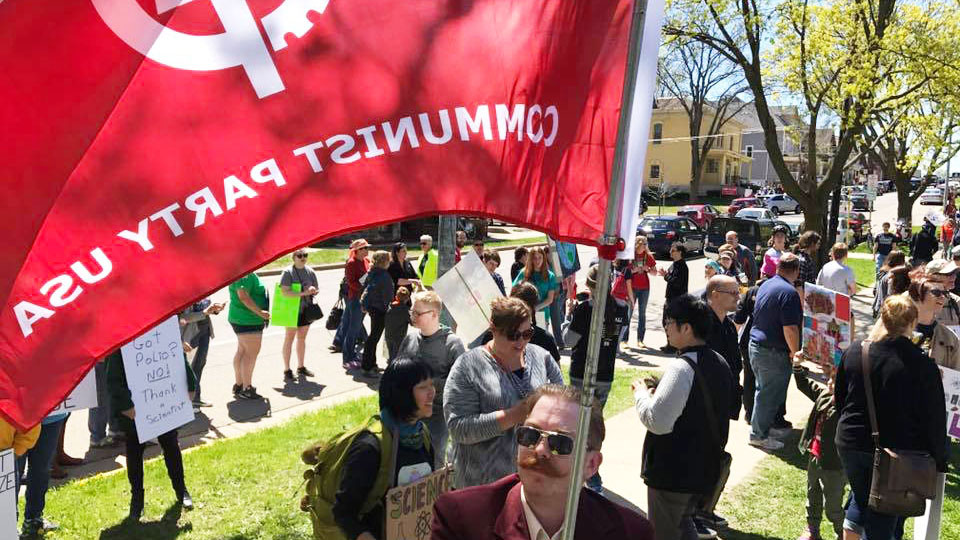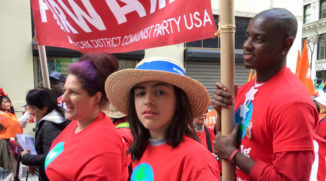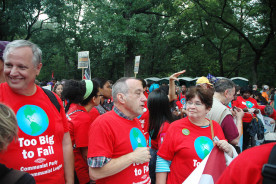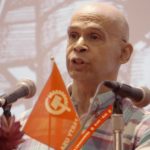
(Keynote to the National Party Building Conference, November 11 – 12, 2017)
Welcome to our national party building conference! We are coming to you live today from LA to New Haven and from Tampa to Minneapolis. We’re streaming from Oakland, Houston, here in Chicago, from the campus of Ohio University, and from St. Louis. Welcome one and all to this national conference to build our revolutionary working-class party.
Our conference occurs just after the historic celebrations of the October Revolution. Over 100 years ago, Russian workers, in ten days, shook the world, and in shaking it, changed it forever.
The October Revolution gave birth to the modern communist movement and aided national liberation and socialism. It gave humanity its first taste of what socialist efforts could accomplish. Despite all the challenges and setbacks – and we do not underestimate them – one truth stands out: workers possess the power to rule and change their lives. We learn from our mistakes, pick up the class struggle and democratic banner, and fight on.
It would be difficult to overstate the importance of holding this conference. It was clear even a year ago that if we hadn’t already decided to have a national conference, given the danger posed by Trump, we’d need one anyway.
What we didn’t appreciate then was just how much we’d need it. We knew Trump would be a danger – perhaps the greatest danger our country has ever faced. But we didn’t anticipate how quickly the challenge to democracy would develop. We didn’t anticipate the crisis-a-day style of governing, the degree of raw racism and sexism, the ferocity of the attacks on immigrants and the press, the depth of the threat to the environment, or the pace at which the danger of nuclear war would grow. We did not anticipate that in just nine months of the Trump administration, a national right to work law would be an actual threat to the very existence of the trade union movement as we’ve known it.
We also didn’t anticipate the scale and scope of the fightback that would explode on the national scene in the immediate aftermath of Trump’s election in the “Not my President” protests, the women’s marches around hisi nauguration, the airport protests after the travel ban, and the fight against the attempt to repeal Obamacare.
Yes, the resistance was born! And with it, an understanding of the degree of the danger faced and the scope and scale of the fightback. Among large sections of the American people, there was no ducking and dodging about what Trump represented. People understood that there could be no normalizing of the racist, anti-Semitic, sexist, and homophobic bigotry he brought to the surface. The American working class and people realized that these were the seeds of fascism.
They have also come to see the importance of next year’s midterm elections. All across the country in towns large and small, those within resistance ranks and beyond are planning to challenge the Republicans’ grip on the U.S. House and Senate. Already, hundreds of candidates, some of whom are brand new to elections, have declared their candidacy, are raising money, and beginning to organize campaigns.
Let us be clear: we can do no less. Everything depends on defeating the GOP next year. Our approach to building the party in the next several months must be in the context of working in the broad democratic campaigns to register and engage voters, raise money, and bring out the vote. Where appropriate, this must include fielding our own candidates. Left candidacies that are part of the broad coalition against the right can play a positive role. Resistance means defeating the GOP and the neo-fascists grouped in and around the Trump administration.
Luckily, the resistance has also given rise to not only a rekindling of democratic and progressive activism but also a demonstrable shift to the left. Indeed, even before the Sanders candidacy, polls demonstrated a significant growth in support for socialist ideas, particularly among millennials. And of course, Bernie’s campaign put the socialist idea on breakfast, dinner, and barroom tables all across the country.
The party is growing
Needless to say, this has created a new situation for the building of our party. And we’re happy to report that we’re beginning to do just that, with over 1,000 new members joining since the election. This recruitment started almost by accident. We posted an image of the party’s membership card on Facebook, and almost immediately a few hundred joined.

We’re also happy to report that people are joining face-to-face, sometimes in groups. Last spring at a lecture featuring Ohio party leader Rick Nagin at Ohio University, 12 people joined the party after his presentation. In Chicago, at national chair John Bachtell’s initiative,16 activists signed up at the CPUSA table during last June’s Peoples Summit. A few weeks later, during the Juneteenth Celebration, 30 more were recruited. In Houston, the party club has developed a practice of regularly asking people to join at demonstrations, picket lines, and events. They first ask them to sign a petition, then walk them over to the table, where they’re told, “You should be a member of the Communist Party,” and asked to join. This year, 63 have joined using this method – and counting. In St. Louis, New Haven, and Los Angeles, clubs have developed ties with potential members through their involvement in labor, community, and elections campaigns. They’ve employed discussion groups, cultural activities, and PeoplesWorld.org to invite and convince people to join.
In keeping with our concept of building the party around peoplesworld.org, cpusa.org, and mass communications, we’ve also stepped up our efforts in this area. The new People’s World and CPUSA websites have increased our traffic considerably. We’ve begun the “We Are the Communist Party” publicity campaign on Facebook and for the first time developed a conscious approach to shaping our image and winning new members – and it’s starting to work.
The party is growing. That by itself is a very important development and not something that should be taken for granted. It wasn’t that long ago that this very idea – the ability of the party to grow – was challenged. But the answer to that pessimism is in the new clubs popping up in Austin, TX; Athens, OH; Sacramento, CA; Nebraska; Oklahoma; and Kentucky. The answer lies in the new districts being organized, in the several hundred new members who in the last year have participated in our bi-monthly new member orientations and our monthly webinars. This growth is just beginning. It is not even and in many cases is difficult to organize, but it is occurring and at a rate not seen in many decades.
While celebrating this development, we should not overstate it. This is important because the party is challenged: In many districts we have an aging membership and leadership; some clubs don’t meet; others are not connected to the main struggles of the day; still others have very little if any connection to our websites.
Speaking of our websites, as suggested above, at our last convention and in the meetings of the National Committee since, we put forward the concept of centering our work around peoplesworld.org and mass communications. Doing so was a restatement of an important proposition affirming the Leninist character of our party adapted to today’s circumstances. Today, we once again reaffirm that Leninist character, but the question has to be asked: how have we done in implementing this policy?
Well, the editors of People’s World have done their part. At the recently concluded labor communications convention, they brought home 21 awards, including the top one.
Some districts and clubs are also contributing to making the policy real with articles on the people’s fightback against Trump. Others have email lists and regularly send out PW articles. A few have Facebook pages and Twitter accounts where activities are organized and articles sent out.
But on the whole, we also have to say that we in the leadership have not provided our clubs and districts the tools necessary to develop a specific social media strategy. The article sharing campaign, which had almost a thousand PW readers pledging to share one labor story a week over the last year, has subsided and efforts to build up our email lists have not kept pace.
That changes this weekend. After our workshop on the PW and social media, each club and district will have in hand a social media strategy for your area that we’ll work with you to help implement. Let us also re-pledge this weekend to regularly share important PW articles with our friends, family, and coworkers.
Engaging members new and old
Notwithstanding these problems, it’s also the case that the majority of new members are coming to the Communist Party by means of our websites – several thousand over the last number of years. Over the last year, we’ve prioritized connecting with our membership both new and old. To this end, we’ve created the position of Membership Coordinator and asked Rossana Cambron to carry out this work. A new collective, the Membership and Organizing Collective, has been assigned the task of assisting Rossana’s efforts to work with our membership and build new clubs.
Prioritizing outreach to new members, the Membership and Organizing Collective has held three phonathons in the fall, winter, and spring and attempted to call the over 5,000 new members on our lists. We’ve talked to about 400 new members on these calls, many of whom were hearing from us for the first time, even though some joined several years ago. Our next phonathon will take place on December 2, and we invite all of you to help out. All you need is your laptop or smartphone, a comfortable chair, and an internet connection.
Online education has also been an important way of reaching out to our membership and beyond. Comrade Dee and the Education Department have regularly organized webinars each month which average over 150 registrants and around 70 participants. The last one over-fulfilled our goal of over 200 registrants. These webinars, along with new member orientations, have become a basic means of introducing Marxist science and engaging with those who are coming around us.
And our new members want to engage. Over 400 responded to a membership survey we sent out in preparation for this conference, and more than 120 of them volunteered to become organizers of new party clubs. That figure itself it hugely important: Can you imagine what it would mean if we were able to set up 120 new clubs?
Even if we were able to help set up 50 clubs, it would put us on new footing and change fundamentally what we do.
We have tremendous organizational tasks before us. Consider that 80 percent of the 400 members who responded to the survey are not in clubs. What are we going to do about that? Think about the fact that 79 percent of the respondents have been in the party for five years or less or that 35 percent have been in under a year? Already the ideological and political ramifications of having a brand spanking new party are apparent. Education is vital; club building how-to’s essential; fundraising tips indispensable.
And in fact, that’s why we need this conference: because with regard to party building, we need to change fundamentally what we do. We need to lay the basis here for a national recruiting plan. This plan must include goals and timetables; the assignment of cadre and resources; fundraising to support it, and collectives assigned to follow up on the work.
The recruitment plan has to include use of the PW, a fresh approach to cpusa.org and its use as an organizing tool, and wide publicity – recruitment must be a public event. Our efforts have to include Facebook, Twitter, and other social media. And once again, party building has to be deeply connected to work around the elections. In so doing, we will lay the basis for rebuilding our party – a goal that is clearly within our grasp.
This party we’re building,in many ways, is fundamentally new. it is not something that can be taken for granted. We’d do well to take a moment and reflect on what we have.
If you think about it, it’s really something special, something precious. A collective of ordinary working people tasked with an extraordinary goal: helping change the world.
An organization led by and for workers that seeks to mobilize our class as the leading force in the creation of a new society.
The CP is a political party that works to achieve the political independence of the working class so that it can carry out its historic mission.
And we’re not just any old organization, interest group, or association. We are a political party that works to achieve the political independence of the working class so that it can carry out its historic mission.
And that’s a helluva thing. Think about it. Ordinary working men and women who, having grasped the imperatives of the day – no, more, grasped the imperatives of history – set themselves the task of saving humanity and the planet.
And we’ve done so because the working-class party is self-conscious; it has created its own ideas, its own science, and in doing so, is able to chart our own path and make our own way in world. We create our own thinkers. That is what the party of Karl Marx and Vladimir Lenin, does. That’s what Marxism made possible. That’s what Leninism is: workers – self-confident, conscious, and theoretical – making our own way.
That’s what leading means. And we understand leading not in a narrow way, not as a proclamation, but as something done by example. lead by doing. Lead by winning the trust and confidence of the workers and people. If you can’t, you step aside.
A mass party
We have set out to build a mass party, not a narrow organization of professional organizers and revolutionaries – though we need both.Ours must be a mass organization of individuals, clubs, and collectives organized wherever possible: in neighborhoods and on campuses, online and offline, involved in the day-to-day struggles of our people for a better life.
This is a party that offers no barriers to joining. You give the nod, and you’re in. There are no tests, no preconditions. That is what we’ve constitutionally agreed to and reaffirmed in convention after convention.
But we do not leave people there. We want members to pay dues; to participate in a club; to study, learn, and grow.

Today, this means welcoming members into our ranks who sign up at street tables, on picket lines, at demonstrations, and online. It means giving all of them the ability to participate and treating all of them equally.
There are no “real” members on the one side and “online” members on the other. Such a category does not exist constitutionally, but it sometimes still seems to exist in our minds. Why? Because we’re still influenced by the concept of a cadre party.
A cadre party is an organization of professional revolutionaries with a high level of discipline designed to wage a frontal assault on the capitalist state. It has high standards of membership requiring endorsement by two or three others and votes of admission. It meets in secret and carries out legal and illegal work. It is a concept of the party that emerged in Russia in the early part of the last century, where there was no democratic tradition or civil society.. There were the people on the one side and the state on the other.
After the revolution of 1917, Lenin advanced a different concept of the party, realizing that the model that fit Russia did not fit countries in Europe and the U.S. which had more developed bourgeois democratic traditions. Instead of a cadre party, a mass party was proposed – meaning that conditions for joining were more flexible, as were rules for participating. Winning over by means of elections and mass struggle of a majority of the working class was seen as a necessary condition for moving toward socialism. The united front policy was proposed as the main way of carrying on this out. Electoral struggle and working in mass organizations, be they trade unions, churches, citizens associations or swim clubs – in other words everywhere and anywhere workers gathered – was viewed as essential to communist mass work.
Our party, in the 1970s and 80s, made decisive efforts to apply the mass party concept to our work. We got rid of the two-person endorsement policy and the need for a club to vote in a member as conditions for joining. Since then, we’ve made adjustments as conditions have changed. One big change of course is the growth of the internet and with it the ability of people to fill out a join form and receive an immediate response. And that has created new challenges.
It’s true that some members who join online present unique problems with respect to involvement. Some don’t communicate by telephone, others don’t use email, still others may not be ready to attend meetings but all have indicated an interest in belonging to our party.
So let’s engage them as they’re willing: by texting, on Facebook, or whatever it may be. Let’s allow them to participate as they’re able: by signing a petition; making a donation; writing a letter to the editor or an article for the PW. In this way, we’ll draw some gradually into deeper activity and fuller participation in the communist movement.
The party we want to build
The party we want to build is ours for the making. It is composed of and led by workers of all stripes and varieties. It participates in mass struggles around the basic issues of the day. It both initiates activity and works in coalition with others. It is militant. It fights for unity and sees electoral work as essential to our very existence.
It is public, open, and transparent. It exists offline and online. It works online to organize offline and offline to organize online. It raises money. It engages in ideological struggle. It sees the united front strategy as a way of political life.
It’s role is to organize the working class and people to defeat the extreme right; to fight against racism, sexism, and homophobia and for unity. It seeks to build class and socialist consciousness and advance the cause of a Bill of Rights, socialist USA.
The Communist Party is going to be built largely among millennials. Let’s face it: that’s where the greatest opportunity lies.
And it is a party that is going to be built largely among millennials. Let’s face it: that’s where the greatest opportunity lies. We have to step up our work with the young generation. This is a special question that requires special measures. At our last convention, we made some decisions in an attempt to reorganize our work with a focus on students. This policy has not been implemented well and some big mistakes were made in carrying it out.
Going forward, we need to reassess these decisions and refocus our work. In doing so, we must begin with engaging the comrades responsible for the work. That includes the young communists of the party and also the YCL collectives where they exist. Let’s find forms for doing so and bring the discussion into the National Board and the National Committee so that we can arrive at our convention with a viable policy. Doing so will be indispensable to the party’s growth.
As we get ready to go into our workshops, we should all take a moment and place ourselves in the here and now.
Let’s strive to look at these workshops anew and take into account what is new in the thinking and in the opportunities before us.
If we believe as dialecticians that everything is always in motion, we must conclude that there are new forms of struggle, new tools for that struggle, and different and possibly unfamiliar steps that need to be taken.
Darwin once said, “It is not the fittest that survives; it is the most adaptable.” We are approaching our 100th anniversary,. Over the decades, it has been our party’s ability to adapt to the new that has made our survival possible – that and a clear focus on the working class.
So let us not hesitate to adapt and try new things. Some forms that we use continue to be viable, but other forms do not and only represent a comfort zone. We need to recognize that comfort zones do not move us forward. They may in fact stagnate us.
Today, let’s examine in our workshops what is new that requires us to adapt. Do we need to change our methods of outreach? Redraft the messaging on our websites? Change our concentration areas?
We can do this with confidence. Because of our nearly a century of struggle ,we can contribute the necessary ideological, political, and organizational, ingredients to the mass movements and meet the new situation before us.
As one comrade who wrote in responding to the call to conference said, “Who better to show the way forward? Who better to demand good working conditions, good pay, and pay equality for women and men? The solidarity among workers remains the greatest of strengths.”
Armed with the tools that come out of this conference, we want to envision a brigade like those sent out to remote areas in Cuba and Venezuela to teach people to read. Our brigades will be sent out to build our party and enhance the issues and movements that develop consciousness. We want to raise the call for the transformation of our current system to a socialist one and position our party to lead us to a socialist society.
In closing, let’s not forget our unique role and what we bring to the struggle. First: an insistence on working-class leadership in both the fight for and the creation of a new society. Second: the absolute requirement of unity in the fight: racism, sexism, homophobia, and systemic discrimination of all kinds must be combatted in the the here and now – otherwise we will never get to the future. Third: we point out the systemic roots of the crisis – it’s not individual weaknesses but capitalism that is wreaking havoc on our lives.
Finally, what makes us unique is the unity between theory and practice; we test our ideas against the real world, and when they don’t work we change them. We fight against dogma and for a scientific approach to the struggle. And let’s keep in mind regarding our past practice that, as we’re celebrating the 100th anniversary,we do so with modesty and pride – great accomplishments were made. We also recognize and do not shy away from the weaknesses and even the crimes. Let’s remember that workers did it: workers built a new society – and next time – workers are going to do it even better.
So, let’s go out and defeat Trump and build this party. We’re going to do it and ain’t nobody going to stop us. In the words of the old spiritual, “Ain’t’ nobody gonna turn us around!”


 Join Now
Join Now